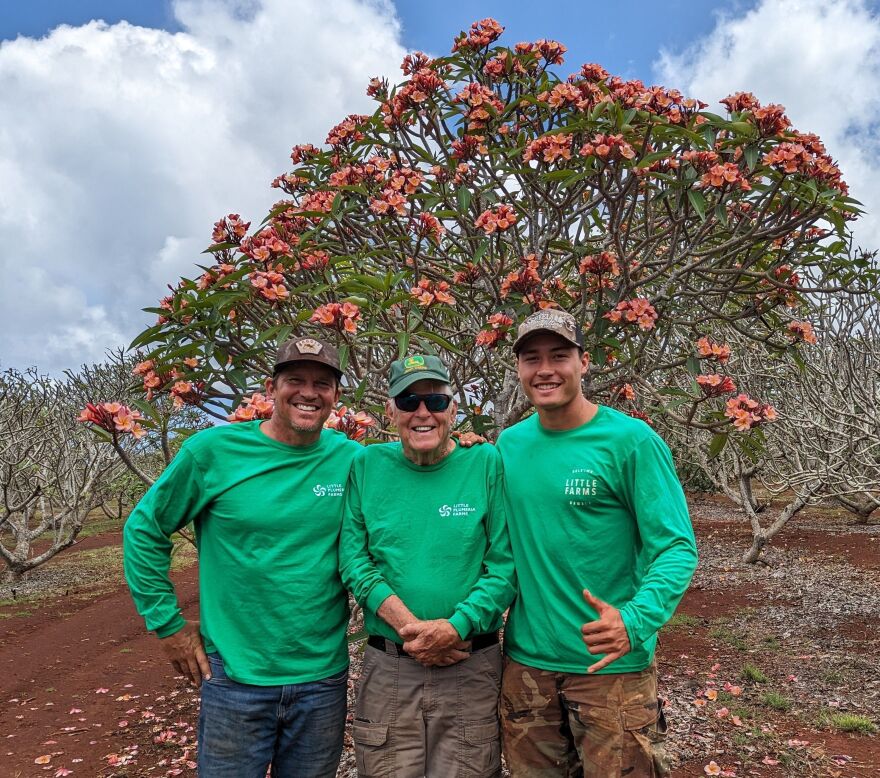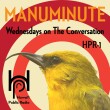This year, Hawaiʻi Public Radio reporters set out to make sense of some of the state's most confusing, weird and beautiful environmental stories.
We shared stories about seaweed-eating goats on Hawaiʻi Island, a renewable energy initiative on Molokaʻi, little fire ants on Maui, mosquitoes on Kauaʻi, and forest bathing on Oʻahu.
Join us as we look back at our favorite earthy stories from 2023.

This Big Island farm feeds their goats seaweed to reduce livestock emissions
What happens when you start feeding goats limu kohu? They may produce low-emissions goat cheese that finds its way onto a Merriman’s restaurant menu. Here's how a staple ingredient in the traditional Native Hawaiian diet benefits the environment, humans and even hooved animals. HPR's Kuʻuwehi Hiraishi visited the farm to bring you this story.
Volcanologist-by-day, musician-by-night combines his love of violin with Kīlauea
Artistic inspiration can come from anywhere. For Leif Karlstrom, it's volcanoes. The scientist turns data into sound and then uses those sounds to make music. HPR's Savannah Harriman-Pote reached out to Karlstrom to hear more about the meeting of his two worlds.
Early plumeria pioneer opens up Haleʻiwa farm to visitors for 50th anniversary
Jim Little's love affair with plumeria began in 1973 after an overgrown tree supplied him with a yard full of cuttings. This year, he and his family — including famous surf photographer Clark Little — welcomed visitors to tour their Haleʻiwa plumeria farm for the first time. The Conversation's Lillian Tsang visited the O'ahu farm and spoke with three generations of Littles.

Beyond the banyan tree, arborists work to preserve Lahaina's 'extremely charred' ʻulu groves
Long before the wildfires ripped through Lahaina, it was a coastal wetland covered in ‘ulu groves. But when arborists went back in October to recover what they could, the trees were black and charred. HPR's Cassie Ordonio spoke with those trying to save the breadfruit.
Scientists appear to be winning a battle against little fire ants in East Maui
It’s been several years since the Maui Invasive Species Committee took a big leap in the battle against the little fire ant — and so far, so good. A pilot project has shown signs of success in Nāhiku on Maui. The Conversation's Catherine Cruz learned all about the effort to curb the stinging pests.
'Voluntourism' after the fires could be a regenerative force for Maui — if done right
Voluntourism has the potential to be a regenerative force in an industry that has historically been extractive of the island's natural and cultural resources. In the wake of the wildfires, organizers began to rethink how visitors could get their hands dirty for a good cause. HPR's Kuʻuwehi Hiriashi shared how malihini, or volunteers, can walk away with a better relationship to the islands and its people.
Therapy among the trees offered on Maui in wake of wildfires
Imagine yourself in the ambiance of the forest. You walk slowly and open your senses. You feel the touch of the breeze on your skin. That's called "forest bathing," defined as making contact with and taking in the atmosphere. The Conversation's Lillian Tsang spoke with Phyllis Look, Hawaiʻi's first certified forest therapy guide.

A closer look at Punahoa Heritage Forest, a reconciliation effort for Hawaiians to heal
Thirty years ago, the United Church of Christ apologized for its complicity in the 1893 overthrow and transferred thousands of acres of land and millions of dollars to a community-based nonprofit. That nonprofit decided to use a portion of that land as a gathering place for Native Hawaiians. HPR's Kuʻuwehi Hiraishi explains the environmental and cultural significance of the Punahoa Heritage Forest.
Hawaiʻi teens lead second youth climate change trial in US history
In April, a climate change lawsuit brought by a group of Hawaiʻi's youth against the state Department of Transportation moved ahead. One of the plaintiffs, 15-year-old Mesina R., said youth stand to inherit a world with severe climate change and they need the state’s help in creating a safe and livable future here in Hawaiʻi.
20,000 male mosquitoes released on Kauaʻi in quest to save native forest birds
Thousands of male mosquitoes were released into the upland forests of Kauaʻi this year in hopes of stopping the near extinction of at least four species of Native Hawaiian honeycreepers. Learn about how this process works and how researchers are keeping track of the progress.
-
Hosted by Patrick Hart
New step in cryopreservation may save hundreds of coral species
Scientists are one step closer to perfecting a method that could save hundreds of coral species from extinction. They employed a technique called isochoric vitrification, which preserves coral samples in a "glassy state." HPR's Savannah Harriman-Pote has this story.
'Equal banana opportunist' shares unique farming knowledge ahead of Banana Festival
If you know Oʻahu farmer Gabe Sachter-Smith, you know he’s bananas for bananas. He started studying the fruit when he was 14 years old. The Conversation's Russell Subiono spoke with Sachter-Smith about all things bananas.
Molokaʻi's community-led renewable energy roadmap serves as an example for other islands
For years, Molokaʻi had a reputation for saying no to renewable energy — but not because residents didn't want it. In October, the community created a roadmap, considered the "first of its kind," to get them to 100% renewable energy. Listen and read this story from HPR's Catherine Cluett Pactol.










